Physical Simulation Experiments of Hydraulic Fracture Initiation and Propagation under the Influence of Deep Shale Natural Fractures
Abstract
1. Introduction
2. Materials and Methods
2.1. Experimental Equipment and Sample
2.2. Experimental Method and Procedure
- (1)
- Polish the irregular residue on the sample surface to make the surface of the samples regular and flat. The installation process of the rock sample can be performed smoothly.
- (2)
- Put the experimental sample into the predetermined position of the triaxial stress loading chamber through the lifting machine. Then install metal cushion blocks between the hydraulic pump and rock sample to make it fully fit with the surface of the sample and ensure uniform stress on the sample.
- (3)
- Add the pre-configured fracturing fluid, which is prepared with glycerin and dye, into the fracturing intermediate container. Then connect the fracturing fluid pipeline outlet with the pressure sensor, and then connect the pipeline with the upper part of the wellbore.
- (4)
- Apply triaxial stress to the rock sample by using the hydraulic pump. In this process, it is necessary to maintain the slow and synchronous loading of three-dimensional stress.
- (5)
- After the triaxial stress of the rock sample reaches the predetermined value, pump fluid into the sample at a small pumping rate to fill the fracturing fluid injection pipeline and wellbore space. When the pipeline pressure has an upward trend, inject fracturing fluid into the wellbore with a pre-designed pumping rate, and record the changes in pumping pressure and pumping rate during fracturing through the data acquisition system. When the pressure curve of the computer acquisition system window shows a sudden drop in pressure, it indicates that the sample has successfully fractured. Then continue to record the change rule of injection pressure with injection displacement.
- (6)
- Stop the pump to complete the test when the predetermined pumping volume is reached. Then remove the sample from the triaxial stress loading chamber with a lifting machine. Use a large cutting machine to cut the sample along the fracture surface, observe and record the space coordinate position of the residual tracer trace from the cutting surface, and determine the shape and extension direction of the crack initiation.
3. Results and Discussion
4. Conclusions
- (1)
- The direction of triaxial principal stress will be deflected by the near-wellbore natural fracture, which causes significant near-wellbore tortuosity propagation of hydraulic fractures. As well, the deflection degree of the triaxial principal stress direction and the probability of hydraulic fractures near-wellbore tortuosity propagation is negatively correlated with the natural fracture dip angle.
- (2)
- The influence of high-dip angle fracture on the maximum and minimum horizontal principal stresses is not obvious. In this case, the propagation of hydraulic fracture is also controlled by the three-dimensional principal stress. With the prefabricated natural fracture dip angle decreasing (from 80° to 60° and then to 40°), the deflection degree of the maximum and minimum horizontal principal stress directions increases. As well, the shape of the hydraulic fracture gradually deviates from the control of maximum and minimum horizontal principal stresses.
- (3)
- The hydraulic fractures will propagate in the direction controlled by triaxial stress in the far-wellbore area after tortuously propagating. For reservoirs with natural fractures, proppant in hydraulic fracturing should be added after the fractures are fully expanded, and the amount of pre-fluid should be increased to prevent sand from plugging in tortuous fractures.
- (4)
- The stress-sensitive effect of natural fractures impacts the permeability of natural fractures and the fracturing fluid leak-off in natural fractures. Natural fractures are easily crossed by hydraulic fractures when their permeability is small. When the difference between the horizontal principal stresses is more than 20 MPa, the spread of fracturing fluid in the natural fracture will be strongly inhibited, and only a part of the natural fracture area in the sample is stained. Therefore, enhancing the permeability of natural fractures with corrosion fracture filler can increase the complexity of the fracture network.
Author Contributions
Funding
Data Availability Statement
Conflicts of Interest
References
- Khormali, A.; Petrakov, D.G.; Farmanzade, A.R. Prediction and Inhibition of Inorganic Salt Formation under Static and Dynamic Conditions—Effect of Pressure, Temperature, and Mixing Ratio. Int. J. Technol. 2016, 7, 943–951. [Google Scholar] [CrossRef]
- Peng, Y.; Zhao, J.; Sepehrnoori, K.; Li, Z.; Xu, F. Study of delayed creep fracture initiation and propagation based on semi-analytical fractional model. Appl. Math. Model. 2019, 72, 700–715. [Google Scholar] [CrossRef]
- Li, Y.; Luo, A.; Chen, X.; Cheng, L.; Chang, C.; Xie, W. A Novel model for simulating the integration process of hydraulic fracturing, shut-in period, and well production. Front. Energy Res. 2022, 10, 979526. [Google Scholar] [CrossRef]
- Zhang, X.; Zhang, J.; Xiao, C. Experimental Investigation of Seepage Mechanism on Oil-Water Two-Phase Displacement in Fractured Tight Reservoir. Geofluids 2022, 2022, 6792154. [Google Scholar] [CrossRef]
- Luo, A.; Li, Y.; Wu, L.; Peng, Y.; Tang, W. Fractured horizontal well productivity model for shale gas considering stress sensitivity, hydraulic fracture azimuth, and interference between fractures. Nat. Gas Ind. B 2021, 8, 278–286. [Google Scholar] [CrossRef]
- Zhai, M.; Wang, D.; Li, L.; Zhang, Z.; Zhang, L.; Huang, B.; Li, A.; Zhang, Q. Investigation on the mechanism of hydraulic fracture propagation and fracture geometry control in tight heterogeneous glutenites. Energy Explor. Exploit. 2021, 40, 246–278. [Google Scholar] [CrossRef]
- Xu, W.; Zhao, J.; Rahman, S.S.; Li, Y.; Yuan, Y. A Comprehensive Model of a Hydraulic Fracture Interacting with a Natural Fracture: Analytical and Numerical Solution. Rock Mech. Rock Eng. 2018, 52, 1095–1113. [Google Scholar] [CrossRef]
- Chen, Z.; Liao, X.; Yu, W. A semianalytical well-testing model of fracture-network horizontal wells in unconventional reservoirs with multiple discretely natural fractures. Nat. Gas Ind. B 2020, 7, 567–582. [Google Scholar] [CrossRef]
- Zhao, J.; Li, Y.; Wang, S.; Jiang, Y.; Zhang, L. Simulation of complex fracture networks influenced by natural fractures in shale gas reservoir. Nat. Gas Ind. B 2014, 1, 89–95. [Google Scholar]
- Guo, J.; Lu, Q.; He, Y. Key issues and explorations in shale gas fracturing. Nat. Gas Ind. B 2023, 10, 183–197. [Google Scholar] [CrossRef]
- Lamont, N.; Jessen, F.W. The effects of existing fractures in rocks on the extension of hydraulic fractures. J. Pet. Technol. 1963, 15, 203–209. [Google Scholar] [CrossRef]
- Daneshy, A.A. Hydraulic fracture propagation in the presence of planes of weakness. In SPE European Spring Meeting; OnePetro: Richardson, TX, USA, 1974. [Google Scholar]
- Warpinski, N.R.; Teufel, L.W. Influence of Geologic Discontinuities on Hydraulic Fracture Propagation. J. Pet. Technol. 1987, 39, 209–220. [Google Scholar] [CrossRef]
- Blanton, T.L. Propagation of hydraulically and dynamically induced fractures in naturally fractured reservoirs. In SPE Unconventional Gas Technology Symposium; OnePetro: Richardson, TX, USA, 1986. [Google Scholar]
- Blanton, T.L. An experimental study of interaction between hydraulically induced and pre-existing fractures. In SPE Unconventional Gas Recovery Symposium; OnePetro: Richardson, TX, USA, 1982. [Google Scholar]
- Zhou, J.; Chen, M.; Jin, Y.; Zhang, G.-Q. Analysis of fracture propagation behavior and fracture geometry using a tri-axial fracturing system in naturally fractured reservoirs. Int. J. Rock Mech. Min. Sci. 2008, 45, 1143–1152. [Google Scholar] [CrossRef]
- Renshaw, C.; Pollard, D. An experimentally verified criterion for propagation across unbounded frictional interfaces in brittle, linear elastic materials. Int. J. Rock Mech. Min. Sci. Geomech. Abstr. 1995, 32, 237–249. [Google Scholar] [CrossRef]
- Zhou, J.; Jin, Y.; Chen, M. Experimental investigation of hydraulic fracturing in random naturally fractured blocks. Int. J. Rock Mech. Min. Sci. 2010, 47, 1193–1199. [Google Scholar] [CrossRef]
- Gu, H.; Weng, X.; Lund, J.; Mack, M.; Ganguly, U.; Suarez-Rivera, R. Hydraulic Fracture Crossing Natural Fracture at Nonorthogonal Angles: A Criterion and Its Validation. SPE Prod. Oper. 2012, 27, 20–26. [Google Scholar] [CrossRef]
- Gong, T.; Xia, B.; Liu, L.; Peng, Z.; Gao, Y. Propagation of hydraulic fracture under the joint impact of bedding planes and natural fractures in shale reservoirs. Energy Sci. Eng. 2019, 7, 2690–2702. [Google Scholar] [CrossRef]
- Fatahi, H.; Hossain, M.; Sarmadivaleh, M. Numerical and experimental investigation of the interaction of natural and propagated hydraulic fracture. J. Nat. Gas Sci. Eng. 2017, 37, 409–424. [Google Scholar] [CrossRef]
- Ai, C.; Li, X.-X.; Zhang, J.; Jia, D.; Tan, W.-J. Experimental investigation of propagation mechanisms and fracture morphology for coalbed methane reservoirs. Pet. Sci. 2018, 15, 815–829. [Google Scholar] [CrossRef]
- Jiang, T.; Zhang, J.; Wu, H. Experimental and numerical study on hydraulic fracture propagation in coalbed methane reservoir. J. Nat. Gas Sci. Eng. 2016, 35, 455–467. [Google Scholar] [CrossRef]
- Zou, Y.; Zhang, S.; Zhou, T.; Zhou, X.; Guo, T. Experimental Investigation into Hydraulic Fracture Network Propagation in Gas Shales Using CT Scanning Technology. Rock Mech. Rock Eng. 2016, 49, 33–45. [Google Scholar]
- Hu, L.; Ghassemi, A. Laboratory-Scale Investigation of the Slippage of a Natural Fracture Resulting from an Approaching Hydraulic Fracture. Rock Mech. Rock Eng. 2021, 54, 2547–2558. [Google Scholar] [CrossRef]
- Shi, Z.; Chen, J.; Gong, D.; He, S.; Jiang, X.; Sun, C.; Fan, L. Experimental study on the shear-slip characteristics of natural fractures in shale reservoirs. Energy Sci. Eng. 2022, 10, 1240–1250. [Google Scholar] [CrossRef]
- Zhang, J.; Yu, Q.; Li, Y.; Pan, Z.; Liu, B. Hydraulic Fracture Vertical Propagation Mechanism in Interlayered Brittle Shale Formations: An Experimental Investigation. Rock Mech. Rock Eng. 2023, 56, 199–220. [Google Scholar] [CrossRef]
- Dehghan, A.N. An experimental investigation into the influence of pre-existing natural fracture on the behavior and length of propagating hydraulic fracture. Eng. Fract. Mech. 2020, 240, 107330. [Google Scholar] [CrossRef]
- Zhang, X.; Yin, M. Investigation of the Hydraulic Fracture Propagation Law of Layered Rock Strata Using the Discrete-Particle model. Geofluids 2022, 2022, 8038085. [Google Scholar] [CrossRef]
- Kolawole, O.; Ispas, I. Interaction between hydraulic fractures and natural fractures: Current status and prospective directions. J. Pet. Explor. Prod. Technol. 2020, 10, 1613–1634. [Google Scholar] [CrossRef]
- Kang, Y.; Hao, Z.; Chen, Q.; You, L.; Chen, M.; Tian, J.; Li, B. Heating-Induced Enhancement of Shale Gas Transport and Its Application for Improving Hydraulic Fracturing Performance. Energy Fuels 2022, 36, 14682–14695. [Google Scholar] [CrossRef]
- Xia, Y.; Tan, P.; Wang, X.; Ren, L. Differences of fracture propagation behavior for two typical fractured formations. Nat. Gas Ind. B 2022, 9, 264–270. [Google Scholar] [CrossRef]
- Chang, X. Laboratory analysis of liquid injection method on hydraulic fracturing initiation and propagation in deep shale formation. Nat. Gas Ind. B 2019, 6, 652–658. [Google Scholar] [CrossRef]
- Daneshy, A. Three-Dimensional Analysis of Interactions Between Hydraulic and Natural Fractures. In The SPE Hydraulic Fracturing Technology Conference and Exhibition; OnePetro: Richardson, TX, USA, 2019. [Google Scholar]
- He, Q.; Suorineni, F.; Oh, J. Modeling Interaction between Natural Fractures and Hydraulic Fractures in Block Cave Mining. In The 49th U.S. Rock Mechanics/Geomechanics Symposium; OnePetro: Richardson, TX, USA, 2015. [Google Scholar]
- Chen, Q.; Hu, H.; Kang, Y.; You, L.; Zhou, Y.; Cheng, Q.; Liang, Y. Mitigating water blockage in shale matrix by acidizing or oxidizing treatment: Evidence from transport pathway change and diffusivity enhancement. J. Pet. Sci. Eng. 2022, 219, 111132. [Google Scholar] [CrossRef]
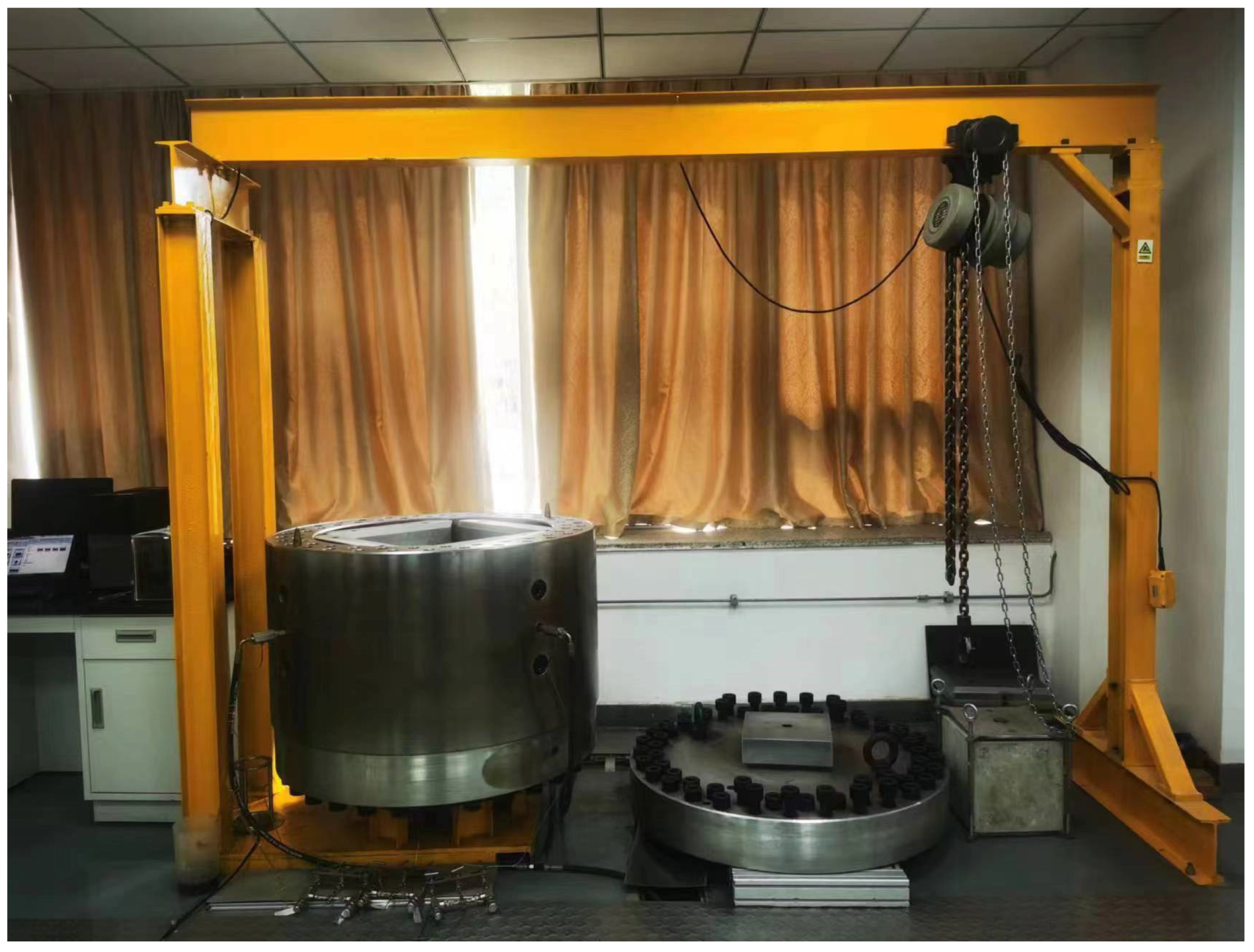

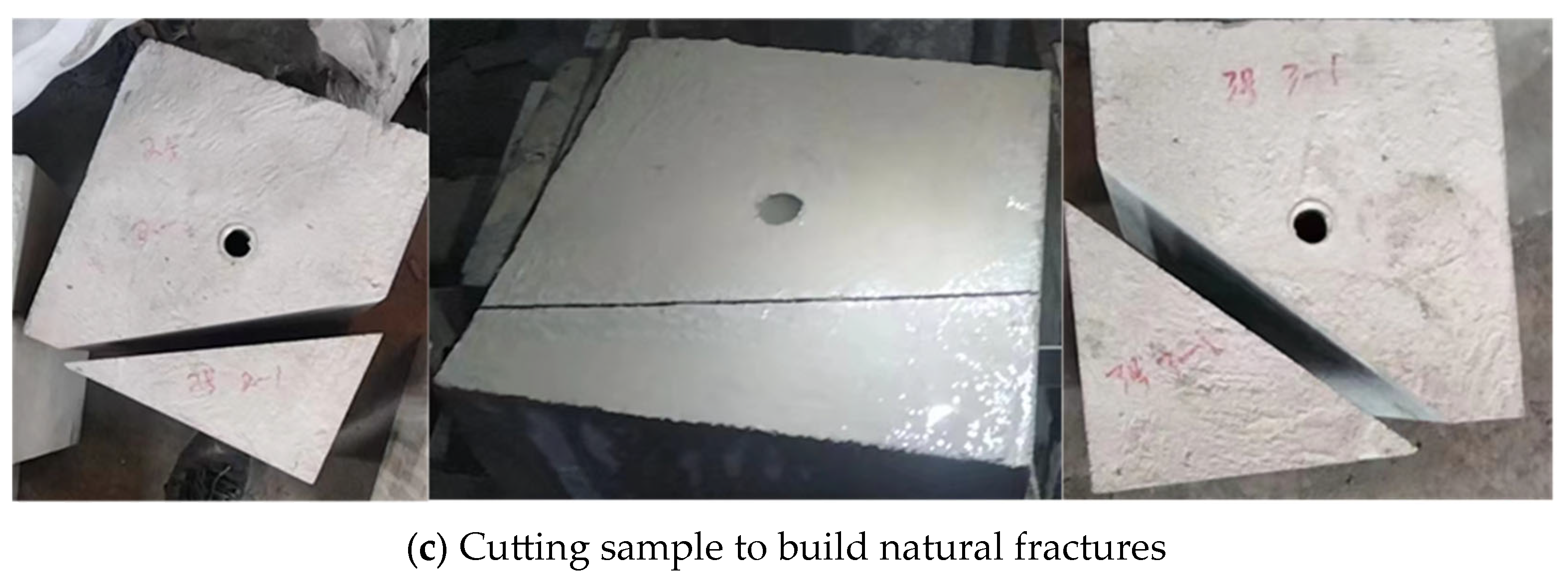
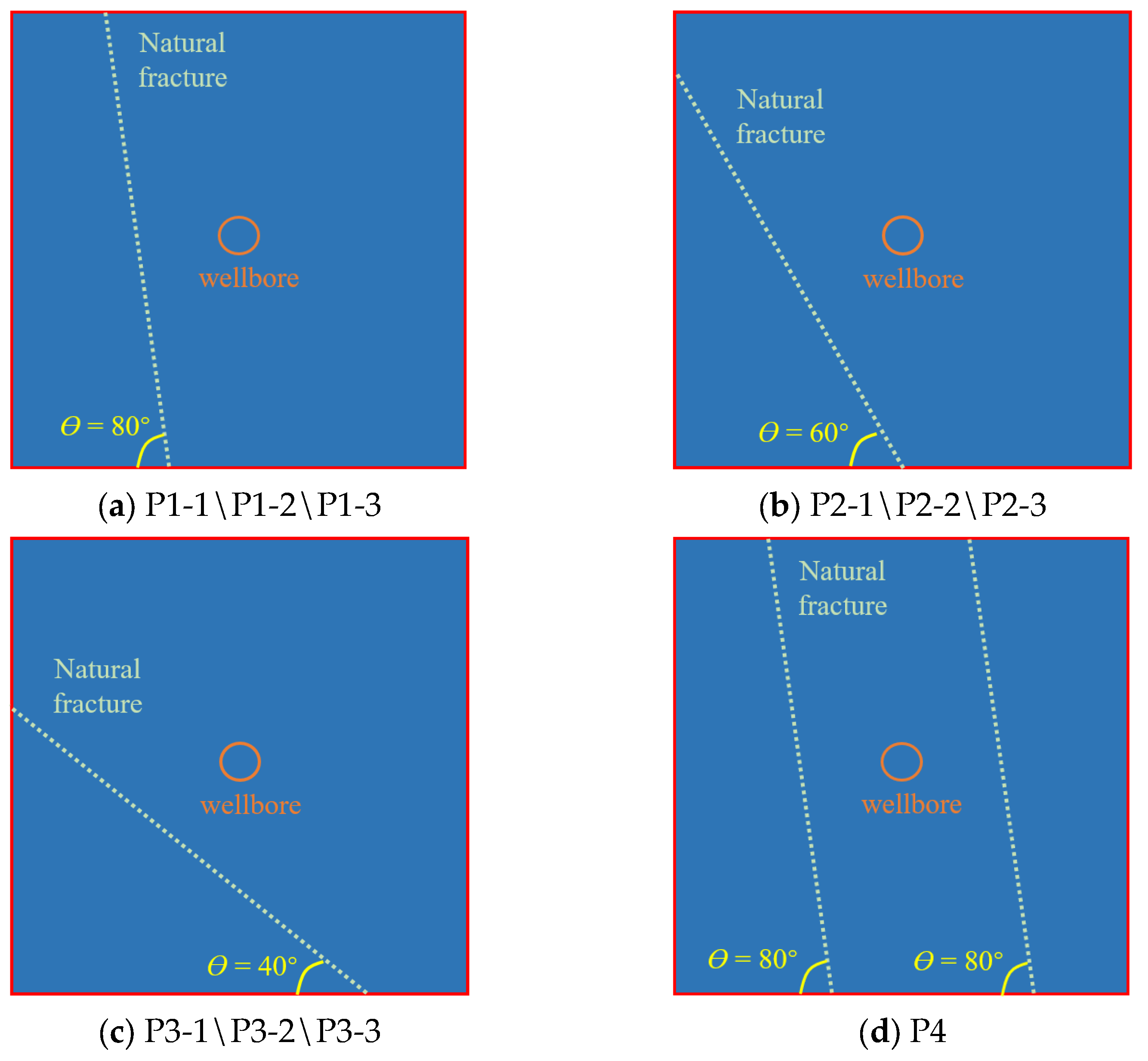
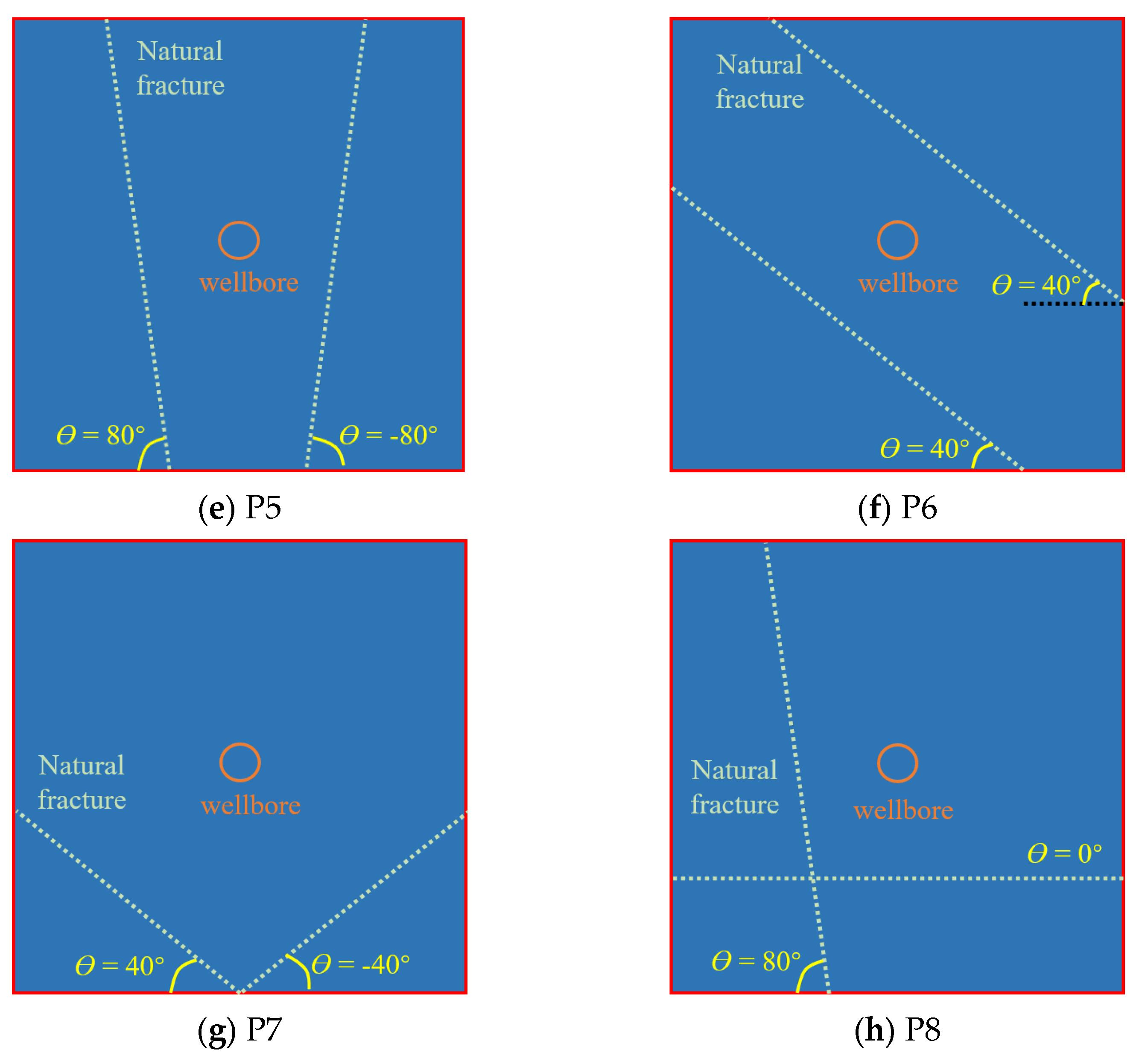


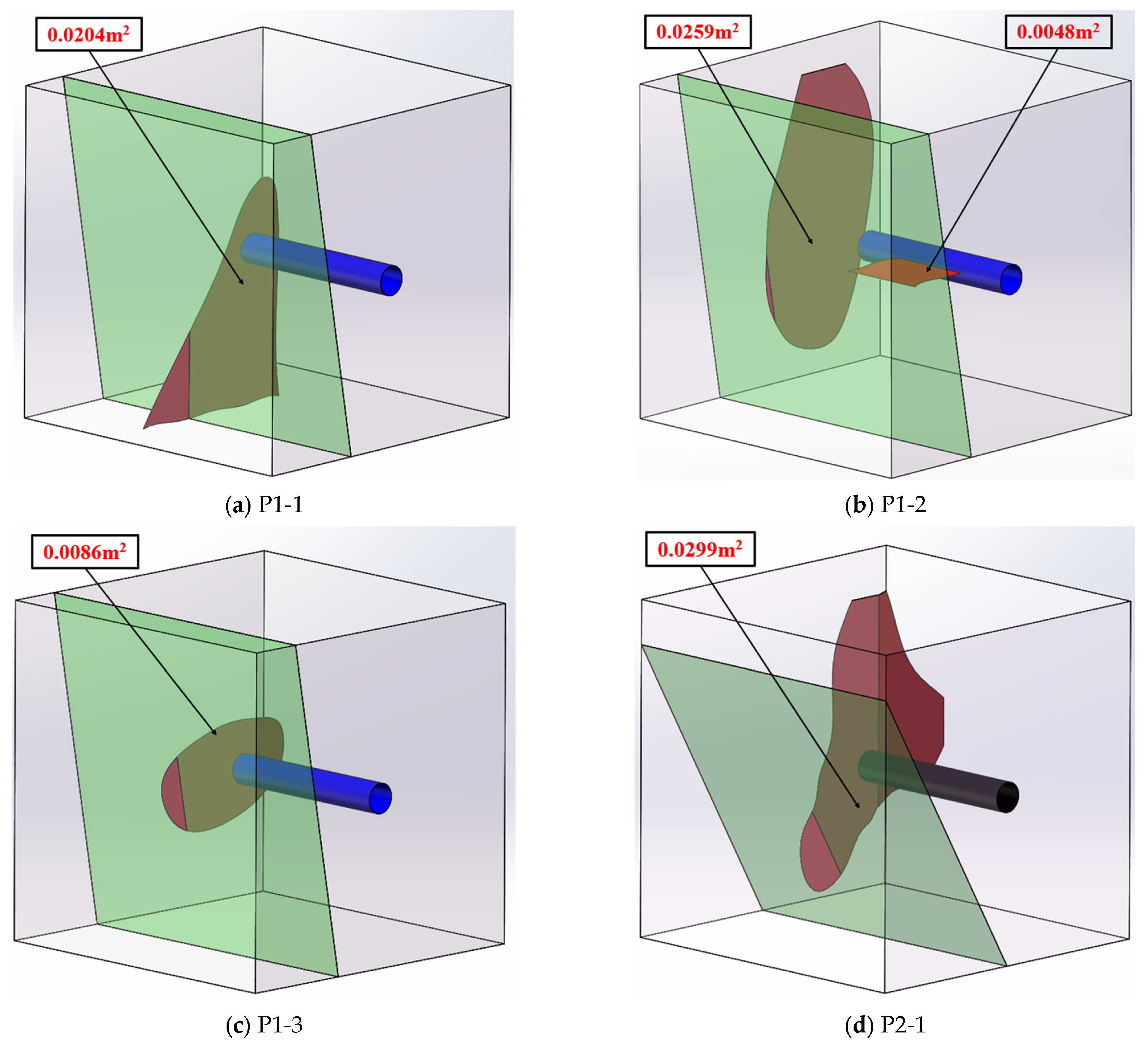


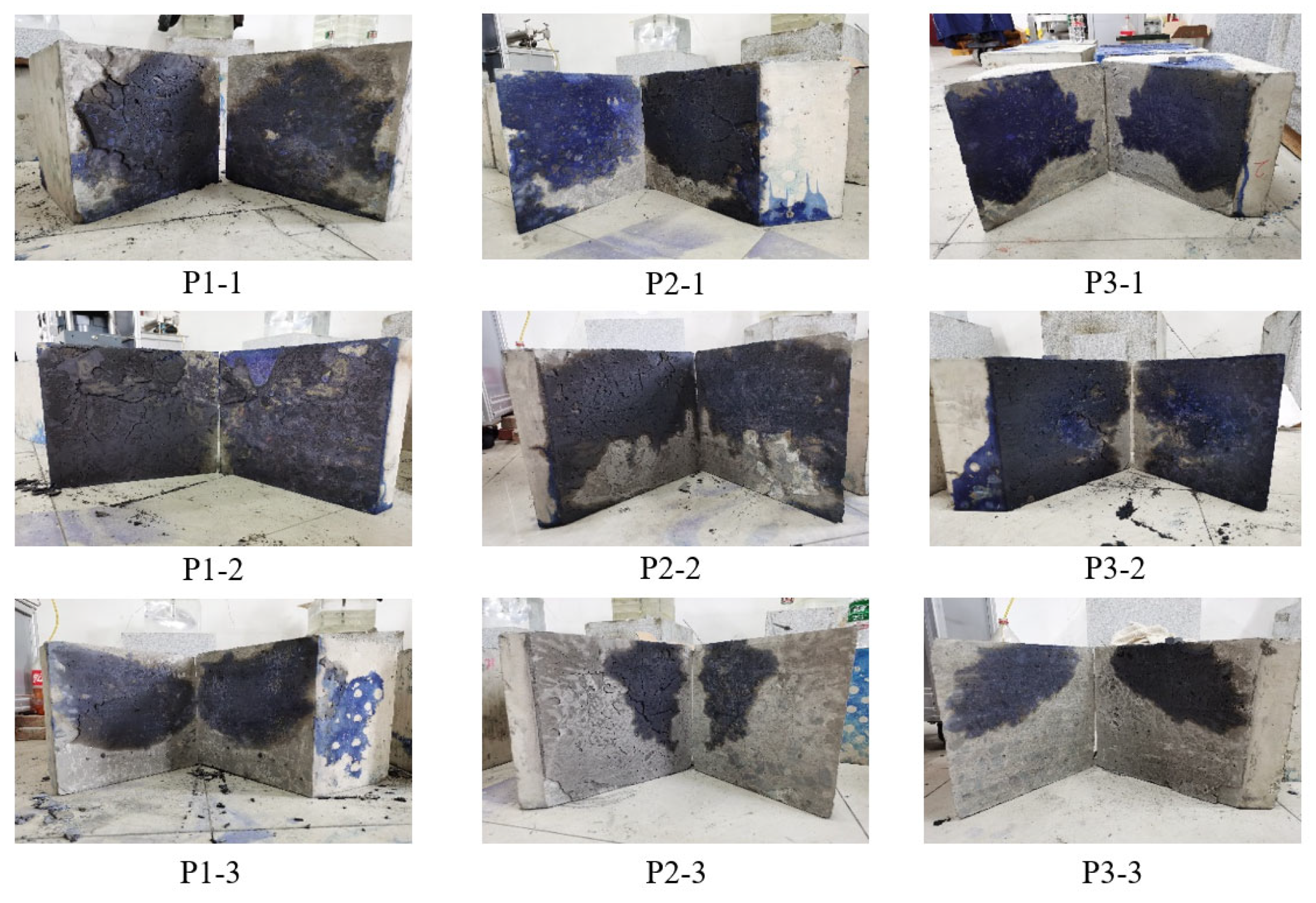
| Sample No | Sizes of Rock Sample (mm) | Depth of the Wellbore (mm) | Length of Steel Pipe (mm) | Inner Diameter of Steel Pipe (mm) | Triaxial Principal Stress X-Y-Z (MPa) | Number of Natural Fracture | Natural Fracture Dip Angle (°) |
|---|---|---|---|---|---|---|---|
| P1-1 | 300 × 300 × 300 | 150 | 145 | 25 | 50-60-60 | 1 | 80 |
| P1-2 | 50-65-65 | 1 | 80 | ||||
| P1-3 | 50-70-70 | 1 | 80 | ||||
| P2-1 | 50-60-60 | 1 | 60 | ||||
| P2-2 | 50-65-65 | 1 | 60 | ||||
| P2-3 | 50-70-70 | 1 | 60 | ||||
| P3-1 | 50-60-60 | 1 | 40 | ||||
| P3-2 | 50-65-65 | 1 | 40 | ||||
| P3-3 | 50-70-70 | 1 | 40 | ||||
| P4 | 50-65-65 | 2 | 80/80 | ||||
| P5 | 50-65-65 | 2 | 80/−80 | ||||
| P6 | 50-65-65 | 2 | 40/40 | ||||
| P7 | 50-65-65 | 2 | 40/−40 | ||||
| P8 | 50-65-65 | 2 | 80/0 |
Disclaimer/Publisher’s Note: The statements, opinions and data contained in all publications are solely those of the individual author(s) and contributor(s) and not of MDPI and/or the editor(s). MDPI and/or the editor(s) disclaim responsibility for any injury to people or property resulting from any ideas, methods, instructions or products referred to in the content. |
© 2023 by the authors. Licensee MDPI, Basel, Switzerland. This article is an open access article distributed under the terms and conditions of the Creative Commons Attribution (CC BY) license (https://creativecommons.org/licenses/by/4.0/).
Share and Cite
Hu, Z.; Chen, P.; Jiang, W.; Yang, Y.; Li, Y.; Zou, L.; Wang, H.; Sun, Y.; Peng, Y. Physical Simulation Experiments of Hydraulic Fracture Initiation and Propagation under the Influence of Deep Shale Natural Fractures. Processes 2023, 11, 1934. https://doi.org/10.3390/pr11071934
Hu Z, Chen P, Jiang W, Yang Y, Li Y, Zou L, Wang H, Sun Y, Peng Y. Physical Simulation Experiments of Hydraulic Fracture Initiation and Propagation under the Influence of Deep Shale Natural Fractures. Processes. 2023; 11(7):1934. https://doi.org/10.3390/pr11071934
Chicago/Turabian StyleHu, Zhou, Pengfei Chen, Wei Jiang, Yadong Yang, Yizhen Li, Longqing Zou, Huaming Wang, Yuping Sun, and Yu Peng. 2023. "Physical Simulation Experiments of Hydraulic Fracture Initiation and Propagation under the Influence of Deep Shale Natural Fractures" Processes 11, no. 7: 1934. https://doi.org/10.3390/pr11071934
APA StyleHu, Z., Chen, P., Jiang, W., Yang, Y., Li, Y., Zou, L., Wang, H., Sun, Y., & Peng, Y. (2023). Physical Simulation Experiments of Hydraulic Fracture Initiation and Propagation under the Influence of Deep Shale Natural Fractures. Processes, 11(7), 1934. https://doi.org/10.3390/pr11071934






